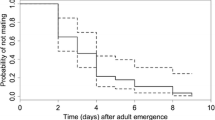Abstract
The parasitic wasp, Cephalonomia tarsalis (Hymenoptera: Bethylidae), parasitizes larvae of the sawtoothed grain beetle, Oryzaephilus surinamensis (L.) (Coleoptera: Silvanidae), and is used for biological control of this worldwide pest of stored grain. To study the hypothesis that C. tarsalis not only mates at its natal patch but also uses olfactory cues to find mating partners elsewhere, we investigated semiochemical use by male C. tarsalis. Olfactometer experiments revealed that male C. tarsalis are arrested by odors emanating from the cocoons of conspecifics, from young unmated females, and from feces of the host. Dodecanal, which was identified from extracts of filter paper contaminated by young females, had an arresting effect on males but not on females and was, therefore, considered as a sex pheromone. These findings indicate that C. tarsalis is a species with partial local mate competition. Males mate with females: 1) at the emergence site following location of females by sex pheromones from their cocoons, and 2) after dispersal from the natal patch following location of females directly by dodecanal and indirectly by unidentified sexual kairomones from host feces.








Similar content being viewed by others
References
Bernal, J. S. and Luck, R. F. 2007. Mate finding via a trail sex pheromone by Aphytis melinus DeBach (Hymenoptera: Aphelinidae) males. J. Insect Behav. 20:515–525.
Charnov, E. L., Los-den Hartogh, R. L., Jones, W. T., and van Den Assem, J. 1981. Sex ratio evolution in a variable environment. Nature 289:27–33.
Cheng, L., Howard, R. W., Campbell J. F., Charlton, R. E., Nechols, J. R., and Ramaswamy, S.B. 2003. Behavioural interactions between males of Cephalonomia tarsalis (Ashmead) (Hymenoptera: Bethylidae) competing for females. J. Insect Behav. 16 :625–645.
Cheng, L., Howard, R. W., Campbell J. F., Charlton, R. E., Nechols, J. R., and Ramaswamy S. B. 2004. Mating behaviour of Cephalonomia tarsalis (Ashmead) (Hymenoptera: Bethylidae) and the effect of female mating frequency on offspring production. J. Insect Behav. 17:227–245.
Collatz, J. and Steidle, J. L. M. 2008. Hunting for moving hosts: Cephalonomia tarsalis, a parasitoid of free-living grain beetles. Basic and Applied Ecology 9:452–457.
Fauvergue, X., Hopper, K. R., and Antolin, M. F. 1995. Mate finding via a trail sex pheromone by a parasitoid wasp. Proc. Natl. Acad. Sci. USA 92:900–904.
Fauvergue, X., Frederic, F., Lemaitre, C., and Allemand, R. 1999. Parasitoid mating structures when hosts are patchily distributed: field and laboratory experiments with Leptopilina boulardi and L. heteronoma. Oikos 86:344–356.
Griffith, N. T. and Godfray, H. C. J. 1988. Local mate competition, sex ratio and clutch size in bethylid wasps. Behav. Ecol. Sociobiol. 22:211–217.
Hamilton, W. D. 1967. Extraordinary sex raios. Science 156:477–488.
Howard, R. W. 1998. Ontogenetic, reproductive, and nutritional effects on the cuticular hydrocarbons of the host-specific ectoparasitoid Cephalonomia tarsalis (Hymenoptera: Bethylidae). Ann. Entomol. Soc. Am. 91:101–112.
Howard, R. W., Charlton, M., and Charlton, R. E. 1998. Host-finding, host-recognition, and host-acceptance behavior of Cephalonomia tarsalis (Hymenoptera: Bethylidae). Ann. Entomol. Soc. Am. 91:879–889.
Landolt, P. J. and Phillips, T. W. 1997. Host plant influences on sex pheromone behavior of phytophagous insects. Annu. Rev. Entomol. 42:371–391.
Metzger, M. 2008. Rôle de l’information dans l’acquisition des partenaires sexuels et le choix du sexe de la descendance chez les hyménoptères parasitoides—Exemple de Venturia canescens Gravenhorst (Hymenoptera: Ichneumonidae). PhD-thesis Laboratoire de Biométrie et Biologie Evolutive, Université Claude Bernard Lyon 1.
Nunney, L. and Luck, R. F. 1988. Factors influencing the optimum sex ratio in a structured population. Theor. Popul. Biol. 33:1–30.
Pérez-Lachaud, G. and Hardy, I. C. W. 1999. Reproductive biology of Cephalonomia hyalinipennis (Hymenoptera: Bethylidae), a native parasitoid of the coffee berry borer, Hypothenemus hampei (Coleoptera: Scolytidae), in Chiapas, Mexico. Biol. Control 14:152–158.
Pompanon, F., De Schepper, B., Mourer, Y., Fouillet, P., and Bouletreau M. 1997. Evidence for a substrate-borne sex pheromone in the parasitoid wasp Trichogramma brassicae. J. Chem. Ecol. 23:1349–1360.
Powell, D. 1938. The biology of Cephalonomia tarsalis (Ash.). A vespoid wasp (Bethylidae: Hymenoptera) parasitic on the sawtoothed grain beetle. Ann. Entomol. Soc. Am. 31:44–48.
Ruther, J., Meiners, T., and Steidle, J. L. M. 2002. Rich in phenomena - lacking in terms. A classification of kairomones. Chemoecology 12:161–167.
Steidle, J. L. M., and Schöller, M. 1997. Olfactory host location and learning in the granary weevil parasitoid Lariophagus distinguendus (Hymenoptera: Pteromalidae). J. Insect Behav. 10:331–342.
Steiner, S., Steidle, J. L. M., and Ruther, J. 2007. Host-associated kairomones used for habitat orientation in the parasitoid Lariophagus distinguendus (Hymenoptera: Pteromalidae). J. Stored Prod. Res. 43:587–593.
Taylor, P. D. and Bulmer, M. G. 1980. Local mate competition and the sex ratio. J. Theor. Biol. 86:409–419.
Thornhill, R. and Alcock, J. 1983. The evolution of insect mating systems. Harvard University press, Cambridge, MA.
Werren, J. H. 1980. Sex ratio adaptations to local mate competition in a parasitic wasp. Science 208:1157–1158.
Werren, J. H. and Simbolotti, G. 1989. Combined effects of host-quality and local mate competition on sex-allocation in Lariophagus distinguendus. Evol. Ecol. 3:203–213.
Zimmermann, O., Schöller, M., and Prozell, S. 2008. A new beneficial in storage protection: The use of the bethylid wasp Cephalonomia tarsalis against the sawtoothed grain beetle Oryzaephilus surinamensis. DgaaE-Nachrichten 22:46.
Acknowledgments
We greatly appreciate the contribution of Kerstin Hacker and Wolfgang Spohn to part of the olfactometer experiments. This work was supported by the German Research Foundation Project number STE 841/6-1.
Author information
Authors and Affiliations
Corresponding author
Rights and permissions
About this article
Cite this article
Collatz, J., Tolasch, T. & Steidle, J.L.M. Mate Finding in the Parasitic Wasp Cephalonomia tarsalis (Ashmead): More than one way to a Female’s Heart. J Chem Ecol 35, 761–768 (2009). https://doi.org/10.1007/s10886-009-9659-8
Received:
Revised:
Accepted:
Published:
Issue Date:
DOI: https://doi.org/10.1007/s10886-009-9659-8




